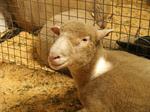
Learn how to breed and care for Sheep
This course will give you the solid foundation that you need to be able to effectively care for or breed sheep. Information covered in the course includes:
- Selection and Breeding
- Nutrition of Sheep
- Diseases affecting Sheep
- General Management of a Commercial Flock
- Lamb Care
- Marketing of Sheep and Sheep Products